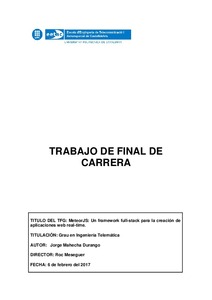Mostra el registre d'ítem simple
Meteor.js: un framework full-stack para la creacion de aplicaciones web real-time
| dc.contributor | Meseguer Pallarès, Roc |
| dc.contributor.author | Mahecha Durango, Jorge Luis |
| dc.date.accessioned | 2017-02-20T10:15:50Z |
| dc.date.available | 2017-02-20T10:15:50Z |
| dc.date.issued | 2017-02-14 |
| dc.identifier.uri | http://hdl.handle.net/2117/101215 |
| dc.description.abstract | Nowadays mostly all the web apps are build using classic and robust technologies such as PHP, JAVA, Python o .NET. These technologies are able to offer powerful frameworks but it is not adapted to the new times where is critical to access on the information and do actions as fast as possible. In this point is where are appearing new technologies such as Node.js, JavaScript and MeteorJS that are offering build flexible and scalable web apps without make the code too complex and always having the control over the app as the data and UI (user interface) are separated. By other hand, these technologies are built to be reactive so any change that has been done in the database or variables are updated automatically. The objective of this project is to evaluate the potential of MeteorJS, since it offers all the tools to make a web application in a simple and quick learning. MeteorJS is a full-stack framework that means that you can develop the entire structure of the application from the server side to the client and making use of a single programming language, which is JavaScript. Among the advantages of developing an application with MeteorJS, is that it offers a package repository, which allows integrating functionalities to the application without having to develop them because of they have already been developed by the community, which implies reducing the time dedicated to the application and can really focus on specific functionalities. An example of this can be the functionality of registering or logging into the application that will be demonstrated during the project and at the same time more demonstrations will be done to evaluate this new framework. The project has been carried out experimentally in which different demonstrations have been carried out to evaluate the potential of the framework. Each of the demonstrations contains a short introduction explaining the objectives to be achieved with each of them, will show the most important steps and pieces of code that have been used to achieve the objectives and finishing with the conclusions about the demonstrations. Once the demonstrations have been completed, the final part of the project will be creating a web application joining all the previous demonstrations and splitting it in different sections. These sections consist of a main page that will be the homepage of the application, a section for feedback, and showing a different menu in case the user is registered. In case the user is registered will be able to create and edit students, create and invite other students to a meeting room or chat room, or join to the meeting room which he has been invited so we will be able to have a real-time conversation with users who are online. |
| dc.language.iso | spa |
| dc.publisher | Universitat Politècnica de Catalunya |
| dc.rights.uri | http://creativecommons.org/licenses/by-nc-sa/3.0/es/ |
| dc.subject | Àrees temàtiques de la UPC::Enginyeria de la telecomunicació |
| dc.subject.lcsh | Real-time data processing |
| dc.subject.other | MeteorJS |
| dc.subject.other | NodeJS |
| dc.subject.other | Frameworks |
| dc.subject.other | Real-time |
| dc.title | Meteor.js: un framework full-stack para la creacion de aplicaciones web real-time |
| dc.type | Bachelor thesis |
| dc.subject.lemac | Temps real (Informàtica) |
| dc.rights.access | Open Access |
| dc.date.updated | 2017-02-16T06:51:57Z |
| dc.audience.educationlevel | Estudis de primer/segon cicle |
| dc.audience.mediator | Escola d'Enginyeria de Telecomunicació i Aeroespacial de Castelldefels |
| dc.audience.degree | GRAU EN ENGINYERIA TELEMÀTICA (Pla 2009) |


